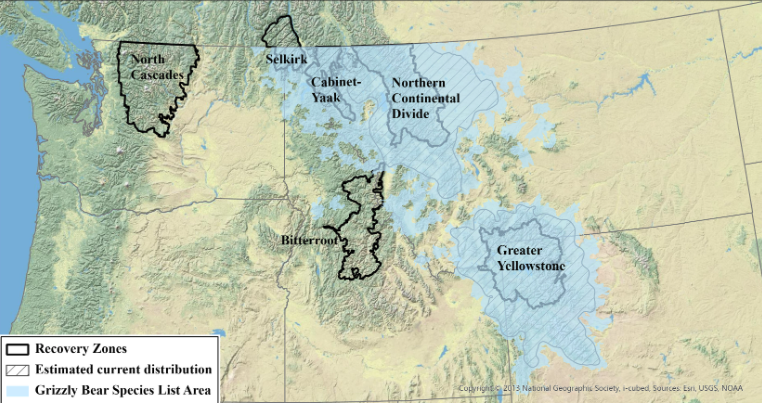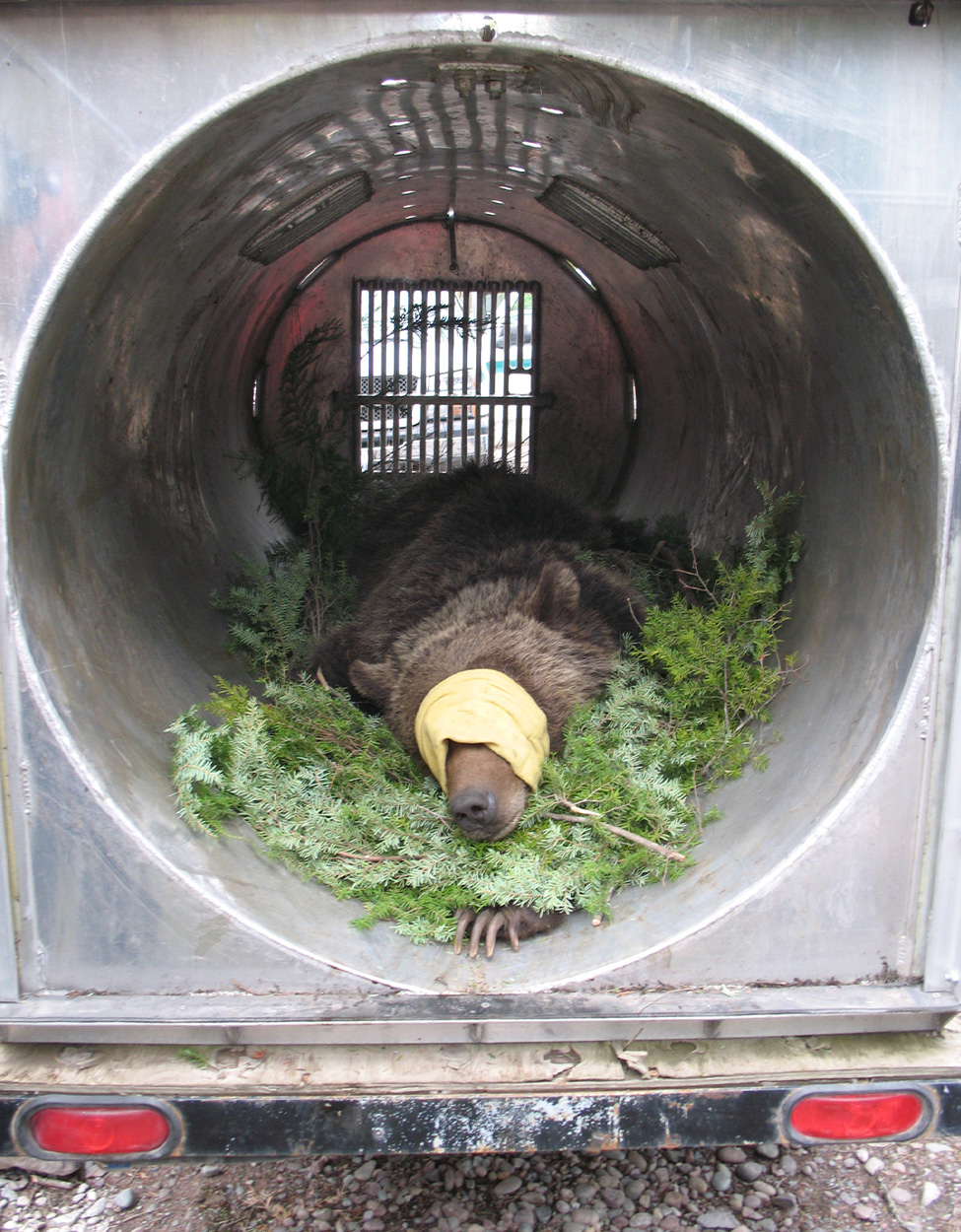Montana’s New Grizzly Bear Plan Shows It’s Ready to Take Back Management from the Feds
On Sept. 26, Montana Fish, Wildlife & Parks released a record of decision adopting the final environmental impact statement and proposed action for its 2024 Statewide Grizzly Bear Management Plan. The finalized plan is meant to prepare the state wildlife agency should grizzly bears be removed from the Endangered Species Act, which could happen as soon as three months from now.
“The 2024 Grizzly Bear Plan will serve to both inform FWP’s state management of grizzly bears as an ESA-listed species and to articulate FWP’s vision of management should … grizzly bear management authority be returned to the state,” the plan reads.
The grizzly population in the Lower 48 has been federally protected since the bears were reintroduced there in 1975. But that could soon change as the U.S. Fish and Wildlife Service said in July that it will release a decision on whether the species should be delisted in January 2025.
Grizzlies in Montana
Since their reintroduction in the 70s, grizzly bear populations have largely trended upward in both the Greater Yellowstone and Northern Continental Divide ecosystems, two of six recovery zones identified by the U.S. Fish and Wildlife Service. (The GYE is mostly in Wyoming, but the northern boundary extends well into Montana.) In recent years, bear populations have also stretched into other habitats within those two zones as they’ve dispersed and expanded their range.
As of 2022, the roughly 965 grizzlies living in the GYE were using 98% of their suitable habitat there, according to the USFWS Grizzly Bear Recovery Report. Similarly, in the NCDE, sows with dependent cubs occupied all 23 bear management units within the recovery zone from 2017 to 2022. That recovery zone now has the highest grizzly population in the Lower 48, with recent estimates showing roughly 1,110 bears there.

Map by USFWS
Judging by the size of these populations and the amount of habitat they occupy, grizzlies in both recovery zones have hit many of the recovery criteria identified by the USFWS. But whether a delisting is in the best interest of the species — one that reproduces at a glacial pace compared to other mammals — remains a source of contentious debate. States like Montana and Wyoming have long argued that they should be able to manage their own grizzly populations, while grizzly bear advocates and animal rights groups have filed repeated lawsuits to keep that from happening.
Then there are everyday citizens, some of whom want to see the species preserved at all costs, and others who think apex predators like grizzlies should be actively managed. A survey conducted in 2020 found that most Montanans trend toward the latter, according to the Montana Free Press. More than 83 percent of those respondents said there should be some form of grizzly bear hunting (although more than a third of those people said this should be “very limited hunting that does not affect population size”), while only 17 percent said grizzly bears should never be hunted.
This debate makes things even more challenging for Montana grizzly bear managers, who are also required by state law to protect humans, pets, and livestock from conflicts with grizzlies. Some of the language in MFWP’s new management plan is a nod to this complicated balancing act.
“FWP views grizzly bears as both ‘conservation-reliant’ and ‘conflict-prone,’ and embraces the challenges of ensuring the species’ healthy future, while ensuring the safety of people and their property,” the plan reads. “As Montana supports a thriving grizzly bear population, FWP will continue its internationally recognized conflict prevention and response program.”
An Impending Decision
On July 26, USFWS regional director Matthew Hogan submitted a declaration to the U.S. District Court of Wyoming signaling the agency’s intent to finalize its decision on the listing status of grizzly bears in the Lower 48 by Jan. 31, 2025. The deadline marks the potential end of what has been a dramatic and drawn-out series of petitions and lawsuits over that listing status from both Western states and advocacy groups. With that date less than four months away, it’s crucial that an updated management plan is in place, MFWP communication and education division administrator Greg Lemon tells Outdoor Life.

Photo courtesy Northern Divide Grizzly Bear Project / NPS
“We’re not just sitting around,” Lemon says, pointing out how MFWP relocated two grizzly bears from the NCDE to the GYE in August to encourage genetic diversity between the two population segments, another delisting criterion. “This management plan provides us guidance today on some portions of grizzly bear management, though obviously not all of it yet.”
Some details of the plan reflect a series of updates to the Administrative Rules of Montana regarding state management of grizzly bears in the case they’re delisted. The updated ARM addresses a variety of grizzly management specifics, like a rancher’s lawful ability to kill a grizzly in the act of attacking their livestock (even on public land, which OL hunting and conservation editor Andrew McKean expands on here). It also calls for a 5-year delay from the time of delisting before the Montana Fish and Wildlife Commission would be able to consider a grizzly bear hunt.
Read Next: The Clock Is Ticking as the Feds Grapple with Delisting Grizzly Bears
“FWP would prepare for a conservative grizzly bear hunting season if not federally listed, but the decision on whether to establish a hunting season would rest with the Commission,” the plan reads. As in most other states, the Montana Fish and Wildlife Commission is a governor-appointed group of citizens that makes wildlife management decisions based on input from MFWP biologists, other experts, and the public.
“FWP recognizes the strong views held by many members of the public,” the plan reads. “FWP will not recommend a hunting season for at least 5 years after an ecosystem is delisted.”
The Finalized Plan
According to the record of decision, MFWP briefly considered a variety of alternative actions, but most of them weren’t studied in any depth. These ranged from treating grizzly bears like an “undesirable pest species similar to feral swine” (which, MFWP writes in the plan, “runs contrary to the ESA, state law, and FWP’s vision”) to ensuring that the outcomes of human-bear conflicts always prioritize the bears “regardless to the cost of human livelihood or safety.” (That approach would also violate state law.)
Read Next: Montana Legislators, Don’t Blow Our Best Chance to Delist Grizzly Bears
At the end of the day, Montana’s resulting management plan — similar to its plans for other native wildlife — falls somewhere in the middle.
“Black bears and elk are great examples,” Lemon says. “We have regulated hunting seasons, we monitor populations, we adjust take, and we deal with conflicts. There has to be a balance. We can’t not manage the species from a population standpoint, and we can’t just deal with conflicts in a vacuum. Population monitoring is important. Connectivity between populations is important. Dealing with conflicts with all the tools we have in the toolbox will be important.”
The post Montana’s New Grizzly Bear Plan Shows It’s Ready to Take Back Management from the Feds appeared first on Outdoor Life.
Source: https://www.outdoorlife.com/conservation/new-montana-grizzly-bear-management-plan/





